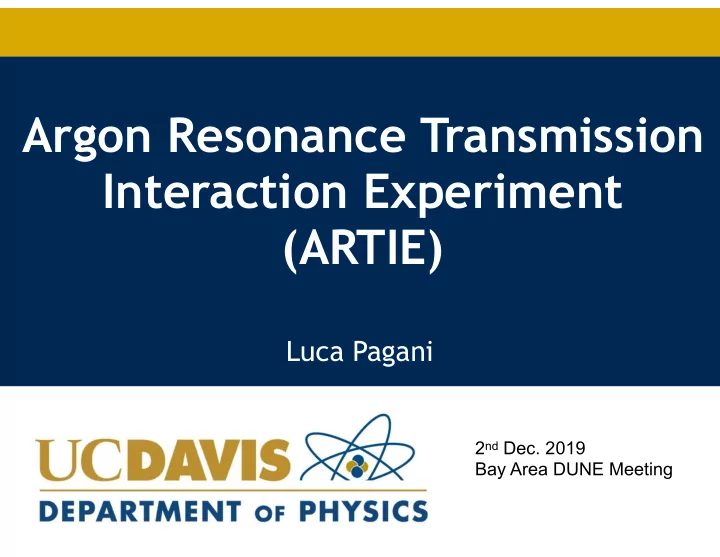

Argon Resonance Transmission Interaction Experiment (ARTIE) Luca Pagani 2 nd Dec. 2019 Bay Area DUNE Meeting
ARTIE Collaboration ▪ UC Davis : R. Svoboda, M. Mulhearn, E. Pantic, J. Wang, L. Pagani, L. J. Pickard, V. Fischer, J. Huang, Y. Bezawada, J. He, T. J. Erjavec ▪ Boston University : C. Grant ▪ LIP (Portugal) : S. Andringa ▪ LANL: J. Ullmann, M. Mocko 2
Why ARTIE? ▪ Leon’s talk: showed we solved discrepancies between measurements from 60s and theoretical prediction (mb) 1400 ENDF/B-VIII.0 σ W. Koehler (1963) 1200 R.L.D. French et al. (1965) N. Ranakumar et al. (1969) This work 1000 Total error 800 600 400 200 2 2 1 − − − 2 10 3 10 10 × × E (eV) n ▪ What about at 57 keV? 3
Why ARTIE? ▪ ARTIE’s goal is to measure the 57 keV neutron anti-resonance Winters et al., 1991 using a liquid argon target. Important for: – Calibration via a Pulsed Neutron Source which relies on the 57 keV anti-resonance – Energy reconstruction , if neutrons don’t travel far from the vertex – Supernova and solar neutrino physics ▪ One previous experiment did not see the anti-resonance at 57 keV, but may not have been sensitive enough 4
Previous measurements ▪ ENDF predictions: ▪ Previous measurements (Winters et al.): ▪ 37 atm target 2.216 m long to give ~0.2 atoms/b ▪ Measured a total cross-section ~0.08 barn @ 57 keV ▪ Difference in transmission coefficients between Winters’ data and ENDF prediction, given T(E) = exp[ -n σ ] is: ▪ T(E, σ =0.0116 b) = exp[-0.211*0.0116] ≃ 99.8% ONLY 1.5% effect vs. T(E, σ =0.08 b) = exp[-0.211*0.08] ≃ 98.3% 5
The ARTIE experiment ▪ Uses a 1.68 m long x 1” diameter ( ≫ beam size) liquid argon (99.99% pure) target with a column density of 3.5 atoms/b: Gas argon vent Liquid argon fill & buffer volume Target pipe Foam insulation Gas collar ▪ Kapton windows ends (allows neutron to go thought) flushed with dry gas (avoid ice formation due to air moisture) 6
ARTIE is very sensitive ▪ Given a column density of 3.5 atoms/b, the target is ~15 times thicker than Winter’s and: ▪ T(E, σ =0.0116 b) = exp[-3.5*0.0116] ≃ 96.0% vs. T(E, σ =0.08 b) = exp[-3.5*0.08] ≃ 75.6% ▪ Difference in the transmission coefficient will be ~19% (very sensitive) 7
ARTIE @ LANL: 10-20 th October 2019 ▪ Optimized tungsten spallation target provides a high peak flux with a broad wavelength bandwidth ▪ Typical beam pulse width is ~125 ns (FWHM). E.g. at 60 meters a 1 keV energy difference is about 150 ns, so about 150 µ s across the 10 keV wide resonance – GOOD ENOUGH to see the ”dip” ▪ Typical beam pulse spacing is 50 ms (~20 Hz trigger rate) ▪ 800 MeV proton beam on a cold target viewed by long TOF lines in Flight Path 13 should give adequate flux 8
ARTIE @ LANL: 10-20 th October 2019 ▪ 6 Li glass detector coupled to 2 PMTs as neutron tagging detector to measure TOF ▪ FP-13 configured for making total cross section measurements: uses an evacuated neutron guide (8” pipe ~70m long) + collimator (6mm) ▪ Brass target before target 9
ARTIE energy calibration ▪ Energy-time correlation: ▪ where: ▪ mc 2 is the rest mass of the neutron ▪ T is time of flight ▪ L is the flight path ▪ Δ T is time offset (ideally is 0) ▪ Obtained using Cd (Cd filter present to reduce thermal neutrons), Al (inserted in the beam pipe both for background estimation and energy calibration) and Ar itself resonances 10
Moderator function ▪ Moderator adds a time delay that is energy dependent ▪ 2D moderator function is simulated for 10 m flight path using MCNP. It can be scaled to any particular length of flight path. Thanks to LANL folks! ▪ It is an asymmetric function: the median of the moderator response distribution was subtracted from the measured TOF. Then the well-known resonance energies (Cd, Ar, Al) were used to calibrate TOF 11
ARTIE energy calibration (preliminary) Preliminary 12
ARTIE energy calibration (preliminary) Ar+Al resonances Preliminary 13
ARTIE energy calibration (preliminary) Preliminary Cd resonances 14
ARTIE energy calibration (preliminary) Preliminary Not “perfect” … More work needed! 15
Transmission Coefficient ▪ If neutron reaction on compensator is negligible, T exp is near exact ▪ T exp coefficient is always smaller than the real value, which means we always measure a higher cross-section ▪ Need to minimize the contributions from non-argon materials (Kapton window, gas flushing collar, air…), or apply a small systematic correction with the help of reference materials 16
How to determine the background ▪ Black notch resonance method: “place material in the neutron beam that have resonances with large cross sections at specific neutron energies. This allows to remove all the neutrons in the beam at that energy, leaving only the off-energy neutrons and gamma rays to interact with the detector” http://accapp17.org/wp-content/2017/data/pdfs/158-22827.pdf, (2012) 17
How to determine the background ▪ Inserted 2” Al but … 18
How to determine the background ▪ Maybe Ar itself 19
Total Cross section NUCLEAR SCIENCE AND ENGINEERING: 172, 268–277, (2012) 20
What’s next ▪ Finalization of energy calibration and relative systematics ▪ Determination of the golden data set ▪ Better understanding of effective columnar density in the target: it is mostly liquid but insulation is not perfect so LAr is boiling off ▪ Precise measurement of boiling off rate and its systematic ▪ Determination of the cross section at 57 keV ▪ Analysis is ongoing … so … stay tuned! 21
Recommend
More recommend